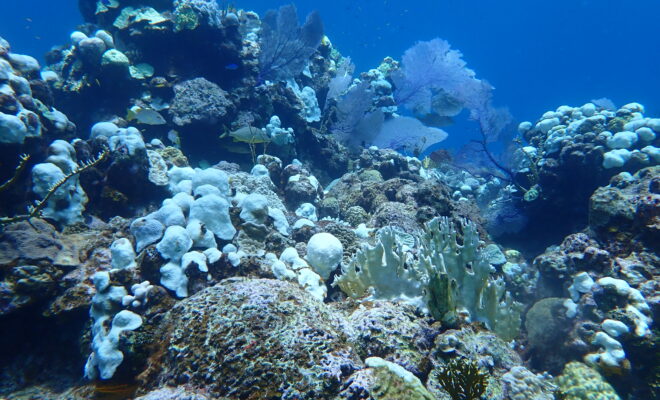By Natalia Hurtado (Perry Institute for Marine Science & Cape Eleuthera Institute at The Island School)
Embrace the Season: Are You a Fan of Summer?
For both Bahamians and visitors, summer offers a fantastic opportunity to embrace the water’s allure, engaging in activities such as swimming, snorkeling, spearfishing, or scuba diving. During this season, the water temperature reaches a delightful warmth, eliminating the need for wetsuits or premature exits due to chilling temperatures. However, keen observers who’ve had the privilege to explore the coral reefs this summer may have noticed unsettling changes. The seawater temperature has spiked beyond its usual range, and the once vibrant corals are displaying distressing signs. Many corals now appear ghostly white, while others have taken on a pallid hue, and regrettably, some have died. The crystal-clear waters of the Bahamas, now reveal how shallow areas have undergone a noticeable shift, diverging from their former vibrant splendor.

Hotter days, Burning questions: What is happening?
As summer unfolds, the tranquil seascape takes on a different hue, quite literally. The seawater temperature begins to rise, setting the stage for a natural phenomenon known as coral bleaching. However, in recent times, the escalating impacts of climate change have cast a shadow over this delicate ecological balance, intensifying the frequency and severity of ocean heat waves. In mid-August temperatures soared to a scorching 91°F (33°C). Coral bleaching is a striking sight, as once-vibrant corals adopt a ghostly white appearance. Yet, it’s crucial to understand that this bleaching doesn’t signify death but rather serves as a poignant indicator of the corals’ distress. The primary culprit in this distressing scenario is the soaring seawater temperatures, a direct consequence of climate change. Climate change’s impact on coral reefs is profound. The majority of Earth’s excess heat is absorbed by the ocean, causing global ocean temperatures to steadily rise. Although corals exhibit some resilience to temperature fluctuations, the rapid and sustained changes driven by climate change push them to their limits. Extended exposure to drastic temperature shifts leaves corals unable to recover, exacerbating the threat they face. In this battle for survival, understanding the intricacies of coral bleaching becomes essential. The correlation between rising summer temperatures, climate change, and coral distress underscores the urgent need to address and mitigate these environmental challenges to safeguard these underwater wonders for future generations.
From Colorful to Colorless: The Process of Coral Bleaching
Corals display their vibrant colors thanks to a symbiotic relationship with photosynthetic algae residing in their tissues. Coral bleaching occurs when this crucial partnership is disrupted. These remarkable organisms, despite their colorful appearance, are animals that rely on microscopic algae known as zooxanthellae for mutual benefit. In this partnership, corals provide a secure habitat, while the algae reciprocate by producing energy as a source of nourishment and adorning the corals with their captivating hues. Regrettably, when corals encounter stressors such as shifts in water chemistry, pollution, or the pervasive impact of high temperatures, they respond by expelling these vital algae, resulting in their striking whitening. Surprisingly, even in this bleached state, corals remain alive, and if you look closely, you can still spot their tentacles in the images.

Can Corals Bounce Back from Bleaching?
When corals lose their symbiotic algae and bleach, they enter a vulnerable state, susceptible to diseases and potential demise. Corals cannot sustain themselves for long without their essential algae partners; they become weakened and starved. However, when the stressful conditions causing the bleaching recede, corals have the capacity to reestablish their symbiotic relationships and initiate a recovery process. Regrettably, in The Bahamas, coral bleaching has been reported a month ahead of the typical summer peak, and this premature occurrence is expected to result in substantial coral loss. Even if some corals manage to recover, their growth rate will be significantly slowed, and their reproductive capabilities may be compromised. If only a few corals survive, they will face additional challenges in maintaining their vitality, as they will struggle to reproduce and rejuvenate the ecosystem.
What is being done in Eleuthera
Much like coral reefs worldwide, coral populations in Eleuthera are declining at alarming rates, making coral restoration more vital to preserve marine resources and local economies. The Bahamas Coral Innovation Hub project is based in Eleuthera at The Island School. This innovative initiative brings together the expertise and dedication of the Cape Eleuthera Institute (CEI), Perry Institute for Marine Science (PIMS), and The Nature Conservancy (TNC). Through our combined efforts, we are committed to facilitating the recovery of degraded Bahamian reefs and bolstering the resilience of coral populations

Preserving Coral Reefs: Why it Matters and What We Can Do”
Coral reefs play a pivotal role in our lives, serving as vital habitats for countless organisms, bolstering livelihoods, and acting as natural defenses against shoreline erosion and storms. The loss of these intricate ecosystems would be nothing short of tragic for future generations. The repercussions of declining coral populations extend to species reliant on them for sustenance, shelter, and reproduction.
Each one of us has a role to play in preventing coral bleaching and safeguarding these critical ecosystems. By understanding the causes of coral bleaching and minimizing our environmental impact, we can make a difference. Reducing our carbon footprint, endorsing local policies that support sustainability, and practicing energy conservation are tangible steps we can take. However, the most crucial measure remains the urgent reduction of climate-warming emissions.
Let’s not forget that marine debris poses a tangible threat to coral reefs. Proper disposal of trash and active participation in cleanup efforts are essential. But perhaps most importantly, we can amplify our impact by spreading awareness. Educating our communities, families, and friends about the importance of coral reef preservation is a powerful catalyst for positive change. Together, we can ensure the resilience and longevity of these magnificent underwater ecosystems.
